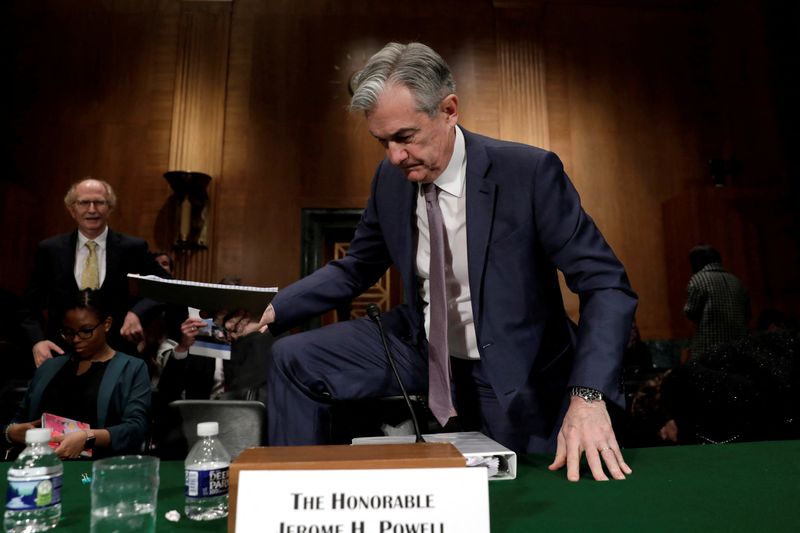
© Reuters. FILE PHOTO: Federal Reserve Board Chairman Jerome Powell steps over a chair after a Senate Banking Committee hearing on The Semiannual Monetary Policy Report to the Congress on Capitol Hill in Washington, U.S., February 12, 2020. REUTERS/Yuri Gripas/File
2/4
By Howard Schneider
WASHINGTON (Reuters) – Minutes from the U.S. Federal Reserve’s latest meeting out Wednesday are expected to detail the breadth of debate at the central bank over how much further interest rates may need to be raised to slow inflation and cool an economy that has remained stronger than expected despite tighter Fed policy.
The two-day meeting ended on Feb. 1 with the central bank raising its target interest rate by a quarter of a percentage point, a return to a more standard rate hike size after a year of sequential three-quarter point and half-point increases.
In a press conference following that meeting, Fed Chair Jerome Powell said the return to smaller rate hikes was meant to allow a more stepwise hunt for a possible stopping point, and that officials spent the session “talking quite a bit about the path forward” as the central bank nears what may be the end of its hiking cycle.
But that session was also held before key data releases that showed unusually strong job gains in January, and showed less of a slowdown in inflation than anticipated – a trend expected to continue this week with the release Friday of a report on how the Fed’s preferred inflation index fared in January.
The Fed uses the Personal Consumption Expenditures price index in setting its 2% inflation target. Economists polled by Reuters estimate it improved only modestly in January, falling on an annual basis from 4.4% to 4.3% once the more volatile food and energy components are excluded. That core inflation measure is seen actually increasing on a month-to-month basis to 0.4% from 0.3%.
Since the meeting, some Fed officials have acknowledged they had pushed to continue with larger half-point rate increases at the last meeting, while investors have boosted their own outlook for where the Fed may end up.
Most do not see the Fed returning to larger half-point increases now that they have slowed.
But they do see the Fed moving rates higher than previously anticipated and leaving them at an elevated level for longer as well – a change in sentiment likely welcomed by Fed officials concerned market pricing had understated their resolve in bringing inflation back to the 2% target.
The minutes, to be released at 2 p.m. ET (1900 GMT), may show just how tilted toward hawkish policy the Fed remains, particularly at a meeting that proved to be the last for former Vice Chair Lael Brainard, who was among the Fed’s most sensitive to the risks facing the economy under tight monetary policy and the most detailed in sketching out reasons for why inflation might slow faster than expected.
Brainard, who left the Fed to head President Joe Biden’s National Economic Council, embodied one aspect of a discussion between those who advise caution in further rate hikes because the economy still has not fully adjusted to what the Fed has done to date, and those who feel businesses and households are proving more resilient than expected to rising interest rates and may need the restraint of even higher interest rates for inflation to fully regress.
While there was little disagreement last year over what the Fed needed to do as inflation raced to a 40-year high, the central bank is now in a more two-sided discussion “to find out to what extent the resilience of the economy thus far reflects time lags on monetary tightening versus a higher short term neutral rate” needed to cause businesses and households to slow spending, analysts for ISI Evercore wrote in an analysis ahead of the minutes.
While the minutes released today are particularly dated, given the jobs and inflation numbers released since then, policymakers will update their views next month with new economic and interest rate projections issued after the Fed’s March 21-22 meeting.


